Our team at Polar Holidays has been visiting Antarctica and its penguin residents for almost two decades! We have put together a fantastic fact sheet to answer any and all questions you may have about these adorable flightless birds.
All penguin species evolved in the southern hemisphere where there are virtually no predators. In fact, there are zero modern-day predators to threaten penguins in Antarctica. This is in stark contrast to the Arctic where there are a variety of predators such as foxes, wolves, and polar bears. Penguin colonies are found on bluffs and on the rock parts of the continent. They do however traverse the large glaciers on the continent as well.
Some might consider penguins difficult to classify. Most species of penguins live in harsh cold climates and swim. They are warm-blooded, lay eggs, and have feathers; therefore, they are birds by official scientific designation but are flightless just as ostriches, emu, and cassowaries.
Many people mistakenly believe that being warm-blooded makes an animal a mammal. While this is true in the case of fish, reptiles, and amphibians, it is not true of birds. Birds are also warm-blooded, and penguins are birds.
Just because penguins live in water and on land doesn’t make them mammals, fish, reptiles, or amphibians. Interestingly, they almost appear to be “flying” when they swim because they use their flippers in a flapping motion.
Penguins have adapted their wings into flippers that help them swim more easily. Penguins live only in the southern hemisphere (except for one species) and a few species are found in very cold climates such as Antarctica. However, of the 17 species of penguins, most do not live in Antarctica. Some people think that penguins are covered in fur but this is not accurate.
Penguins actually possess feathers, not fur. These feathers are different for most penguins. They are packed very tightly together so that – in pictures or videos – it may look as if they have fur. Penguin feathers are short and dense to give a “skin-like” appearance to penguins. Penguin babies, called “chicks,” are covered in fuzzy down feathers which help to keep them warm. They look quite furry – but again this isn’t fur – it is feathers
Penguins share many observable traits found in other birds as well. They have beaks, wings, lay eggs, have feathers, and incubate their eggs. Penguins also have their eyes located on the sides of their heads to watch for predators like most prey animals, and they have feet that share similarities to those found on ducks, geese, or swans.
Another important piece of penguin information: penguins’ naming taxonomy puts them in the class called “Aves” – which is completely composed of other birds. Penguin beaks do not have teeth. Penguin eggs are hard-shelled, unlike the soft-shelled eggs found among most fish, amphibians, and reptiles. Penguins also breathe air through one-way lungs and do not have gills.
Penguin bones are hollow too. Penguins also possess a cloaca – which is a common cavity at the end of their digestive tract used for the release of both waste excrements and genital (sex-organ) products. Most placental-born mammals do not have a cloaca and the boniest fish do not have one either.
And finally the last bit of evidence for classification penguin information? Penguin DNA is clearly “bird” in nature and does not share as many similarities in its DNA as that found in the DNA of fish, reptiles, mammals, or amphibians.
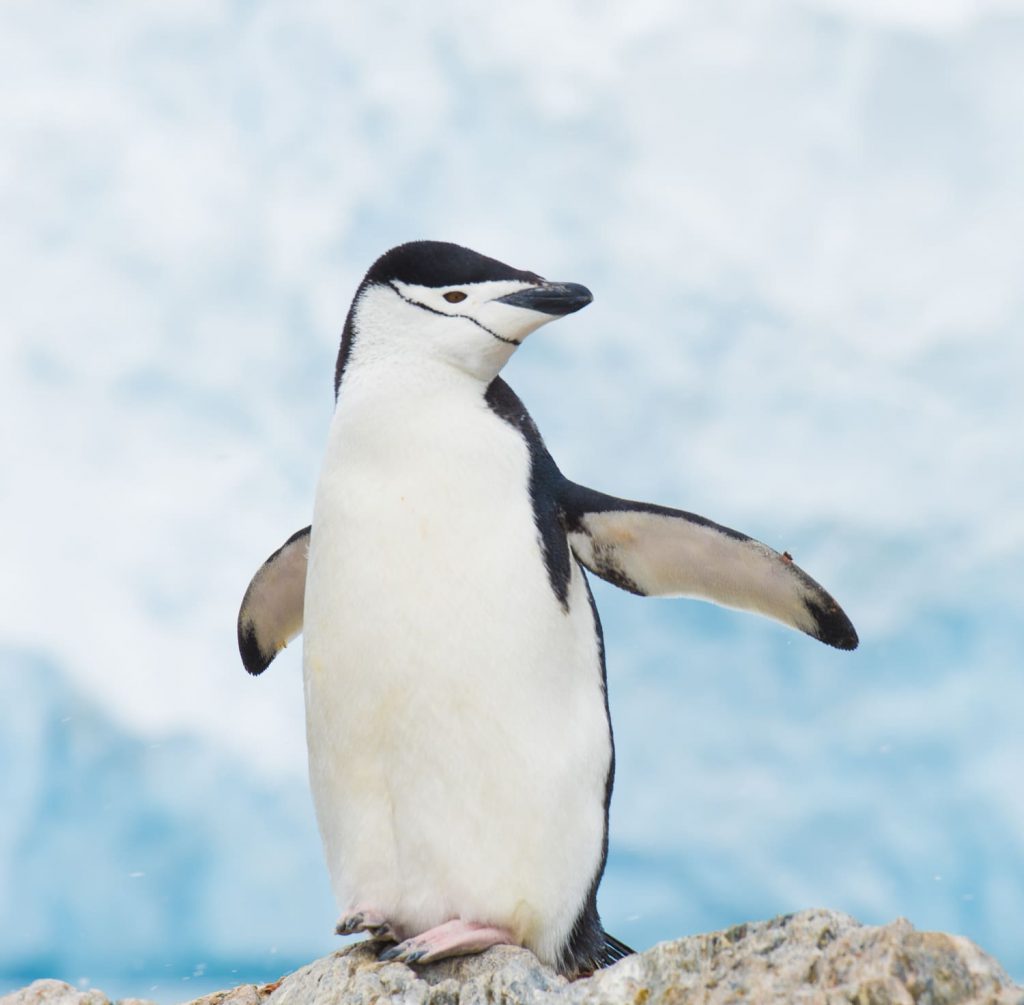
Chinstrap Penguin
One common misconception people have about Arctic Cruises is that they will see Arctic Penguins. Unfortunately, there is no such thing as an “Arctic” penguin. Although it would be a great experience or photo, Arctic polar bears and Antarctic penguins do not exist in the same climate or hemisphere – and live nearly 12,000 miles apart!
Approximately 40 species of penguin may have already gone extinct due to natural processes, disasters, or hunting. Today all remaining species of penguin are legally protected.
Penguin species did inhabit the Arctic in the past. In the 1800s, some explorers tried introducing penguins to the Arctic, but the colonies did not survive due to different conditions and predators. There was also a species called the Great Auk that inhabited the Arctic natively, but went extinct in 1844. The Great Auk was known as “the penguin of the north” even though it was not officially a species of penguin. Interestingly, the modern English word for “penguin” comes from the Great Auk’s scientific name Pinguinus impennis.
While it is unfortunate that this species was driven to extinction by people in the 19th Century, we seem to be doing somewhat better at preserving modern Antarctic penguin species and you will have an opportunity to view some of these by booking one of our Antarctic cruises where we take conservation very seriously.
Penguins are not made of just one species. There are many different species of penguins – and they all belong to the order Sphenisciformes and the family Spheniscidae.
Most scientists place either 17 or 18 species of penguin in the family Spheniscidae. There is debate among scientists about the Rockhopper Penguin species. Some scientists argue that there are two species here: Northern and Southern Rockhoppers
Thirteen of these species are considered vulnerable, threatened, or endangered. The Galapagos Penguin is the only species that sometimes ventures into the northern hemisphere. The most well-known penguin species are African Penguins, Emperor Penguins, King Penguins, Gentoo Penguins, Macaroni Penguins, Rockhopper Penguins, and Little Penguins (also known as the “Little Blue Penguin or Fairy Penguin).
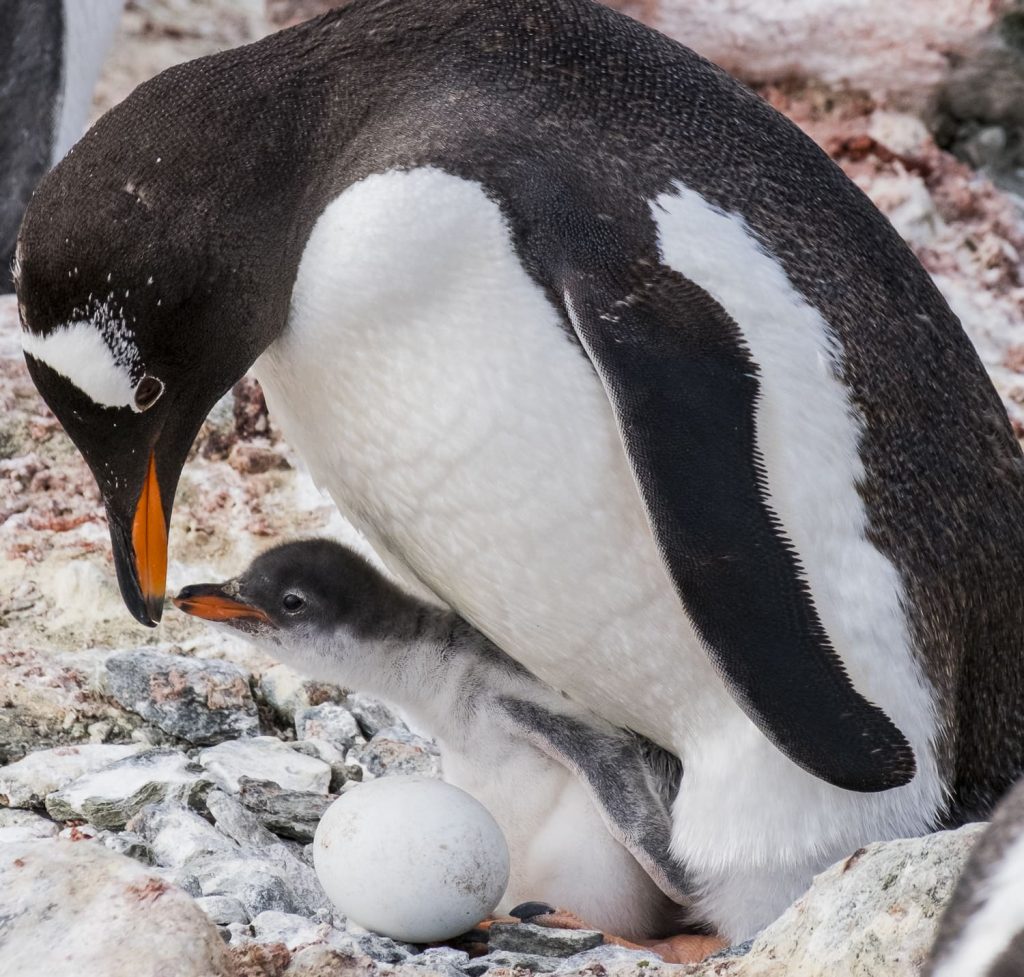
Gentoo Penguin, Chick, and Egg
Adélie Penguin – Pygoscelis adeliae
African Penguin – Spheniscus demersu
Chinstrap Penguin – Pygoscelis antarcticus
Emperor Penguin – Aptenodytes forsteri
Erect-crested Penguin – Eudyptes sclateri
Fiordland Penguin – Eudyptes pachyrhynchus
Galapagos Penguin – Spheniscus mendiculus
Gentoo Penguin – Pygoscelis papua
Humboldt Penguin – Spheniscus humboldti
King Penguin – Aptenodytes patagonicus
Little Penguin – Eudyptula minor
Macaroni Penguin – Eudyptes chrysolophus
Magellanic Penguin – Spheniscus magellanicus
Northern Rockhopper Penguin – Eudyptes moseleyi
Royal Penguin – Eudyptes schlegeli
Snares Penguin – Eudyptes robustus
Southern Rockhopper Penguin – Eudyptes chrysocome
Yellow-eyed Penguin – Megadyptes antipodes
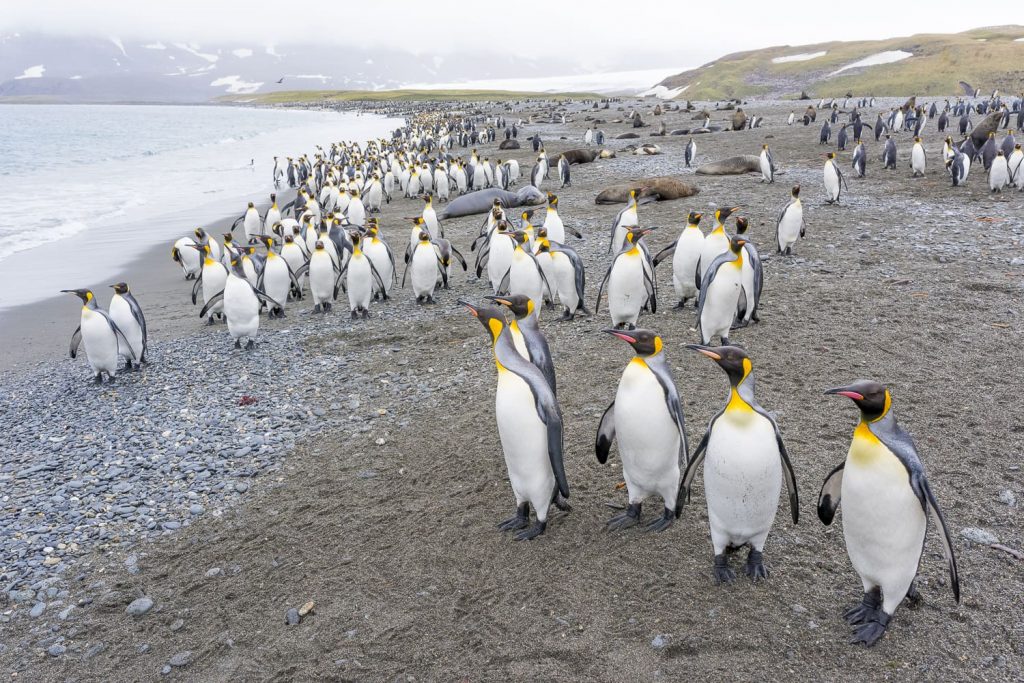
King Penguins
In terms of amazing Antarctic penguin facts, at best, only 44% of penguin species could be considered “Antarctic” or “Sub-Antarctic”– that’s less than half of all penguin species. But when you consider only species that breed and spend significant time in Antarctica itself, that number falls to just four species or just 23.5% of all penguin species. No matter how we classify penguins, it is accurate to state that most penguin species are not Antarctic penguins!
To summarize, of the 17-18 distinct species of penguin that exist, only 7 live in or near Antarctica
4 penguin species can be considered “true” Antarctic penguins since they breed on or near Antarctica and spend much of their lives in Antarctica. They are the Adélie Penguin, the Chinstrap Penguin, the Emperor Penguin, and the Gentoo Penguin.
Finally, a further three species of penguins live or spend a great deal of time on sub-Antarctic islands like South Georgia Island, Heard Island, or the Falklands Islands. They are King Penguins, Macaroni Penguins, and Rockhopper Penguins.
First of all, penguins cannot take a mate until they have reached sexual maturity. This age varies depending on the penguin species. Some of the smaller penguin species will reach sexual maturity in as little as three or four years. Most species take at least five years. Some males can take up to eight years until they begin breeding.
Penguins practice nest site fidelity. This means that both the male and female will return to the same nesting site every year to mate and rear their chicks.
Penguins are typically monogamous – or more accurately – they practice serial monogamy. Sometimes one partner will return to the couples’ nesting site only to find out that the other penguin has already moved on to another mate.
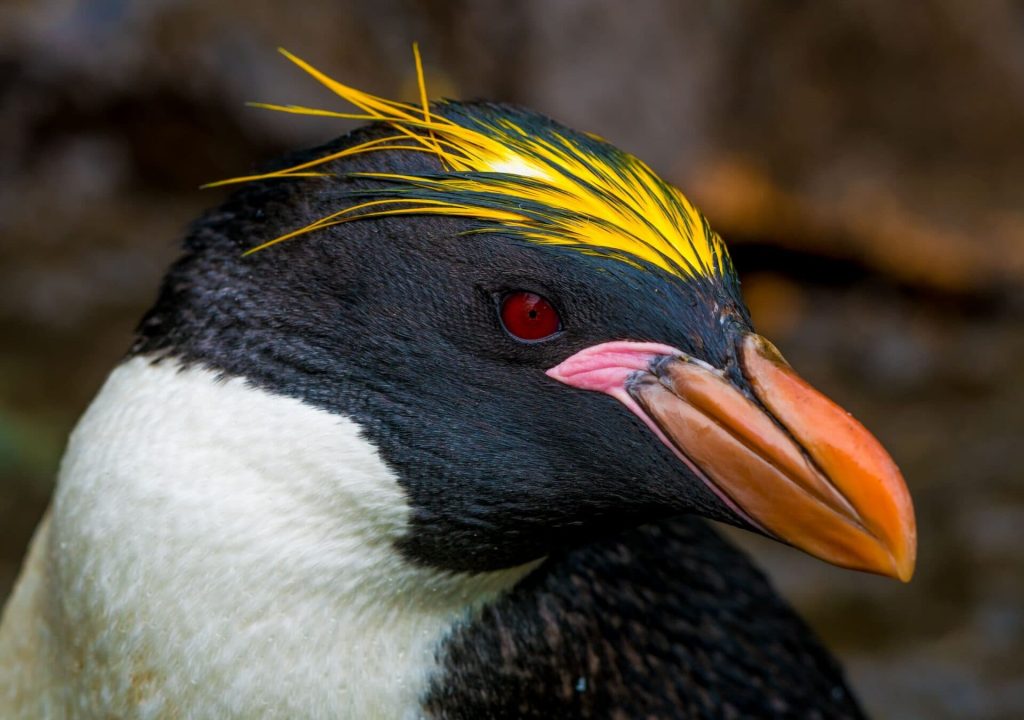
Maccaroni Penguin
They will use both auditory and visual means of signaling that they are ready to mate. It is a cooperative process to raise a chick so the females must carefully choose a mate. Lady penguins are the ones who choose males based on the courtship rituals that are displayed. Male penguins must first choose a good nesting site and then give what’s known as an “ecstatic display.”
First, he will dip his head low, then he’ll rear his head all the way back and stretch his neck back while spreading his wings – rather his flippers – as wide as possible and puffing his chest out. Then he will make a loud “bray” or squawking sound. If the female is interested, she will kind of do a dipping bow. Then the male will reciprocate the bow to agree.
After becoming a pair, the couple will engage in many ecstatic displays to announce their status to the other penguins in the colony. Whenever they re-greet each other or transfer the egg, they will engage in these noisy, movement-filled ecstatic displays of happiness. This strong bond is the key to the successful incubation of the egg and the survival of the chick.
As for the act of penguins mating, the female will lie down on the ground on her belly. The male will climb on her back, walking backward, until he reaches her tail. The female lifts her tail exposing her cloaca, which is a single orifice used both in mating and for waste disposal of urine and feces. The male aligns his cloaca to hers so that sperm can be transferred and this sexually reproductive process leads to the female laying an egg.
King and Emperor penguins lay just one egg each season. The egg is incubated on top of the feet of the penguin without the use of a nest. Many other penguin species will lay two eggs. Nesting materials vary. Some penguins make a nest out of their own guano (feces). Others use natural dips in the land, rocks or pebbles, or other materials. The male generally takes the first incubation shift while females feed and fatten up. The chicks will rely on regurgitated food from the mother once they hatch from an egg. Male Emperor Penguins usually have to wait for the two coldest months of winter with no food while they incubate the eggs, wait for them to hatch, and allow their mate to feed extensively. Once hatched, penguin chicks (baby penguins) may be anywhere from 7cm-10cm tall!
During the courtship ritual, it is thought that the quality of the male’s song can indicate how fat the male is and also his commitment to keeping the egg warm. Females want a male that can survive the full ordeal of incubating the egg while she is acquiring future food stores for the chick.
In the past, it was allowable to eat penguin eggs in places like South Africa and the Falklands Islands. Now all penguin species are legally protected so you cannot eat penguin eggs. Penguin eggs vary in size depending on the species. Emperors have eggs around four to four and a half inches long that weigh 12-18 ounces. Adélie penguins lay eggs that are about 2.2-3.4 inches long.
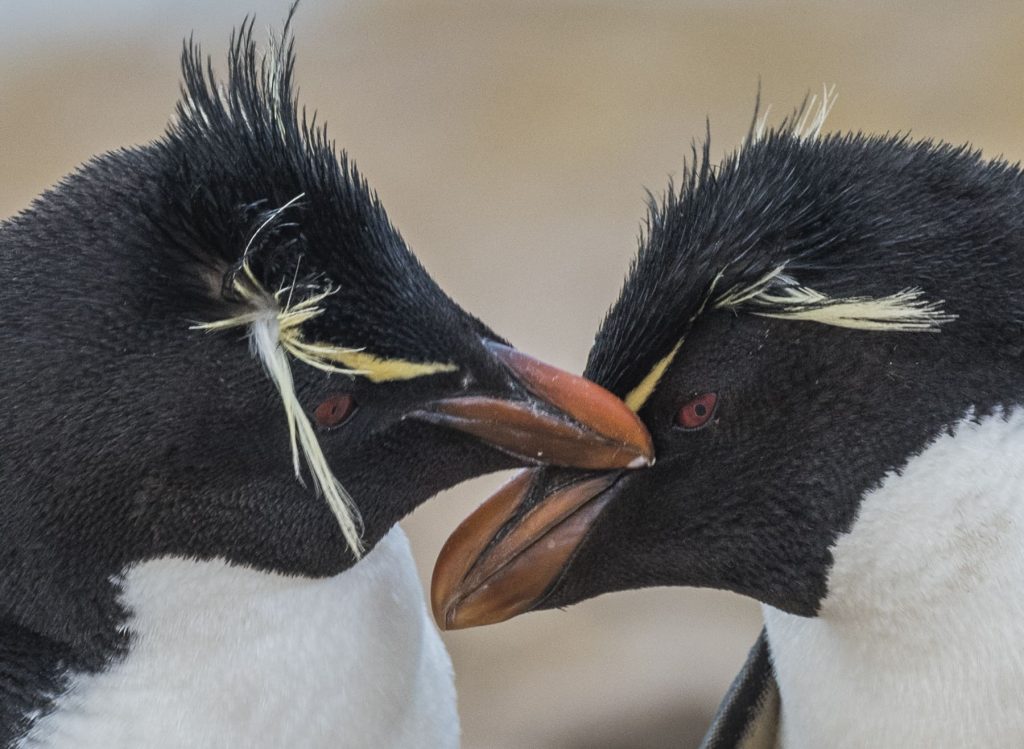
Rockhopper Penguins
Magellanic penguins live the longest at up to approximately 30 years. Emperor penguins can live around 20 years. The Little (Blue) Penguin lives for approximately six years. Penguins who live in captivity tend to live longer due to having less stress, fewer predators, stable sources of food, and higher survival rates for chicks that make it into adulthood.
Penguins cannot fly and this means that they cannot easily escape predators. Therefore, penguin land habitats tend to be islands or continental regions that are free from land-based predators. Examples of such locations include the Galapagos Islands, the Falklands Islands, South Georgia Island, and Antarctica. Many of these penguin-filled locations can be seen on our Polar Holidays Cruises.
Since penguins tend to be predators that eat fish, krill, and other ocean wildlife, their other main habitat tends to be in the water, more specifically, in the open ocean. This habitat does make them more vulnerable to predation where they are hunted by Leopard seals, sea lions, and orcas (killer whales). Most penguins are well-adapted to cold water, salty, marine environments.
Penguin habitats vary greatly by species though, with Galapagos penguins living in the tropics, to Adélie and Emperor Penguins who live smack in the middle of some of the coldest climates on earth.
Emperor Penguin Facts and Interesting Knowledge:
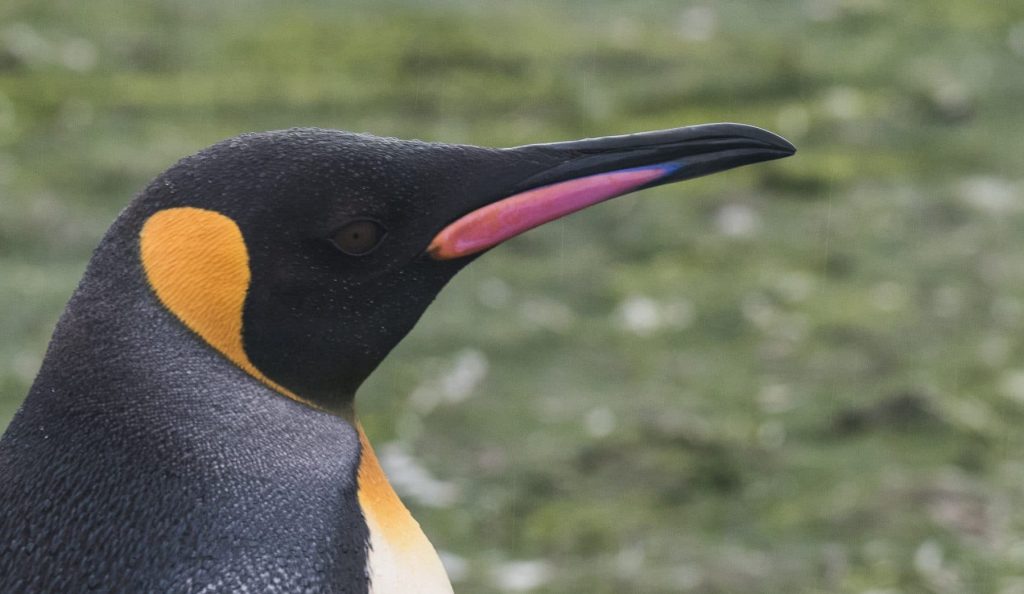
King Penguin
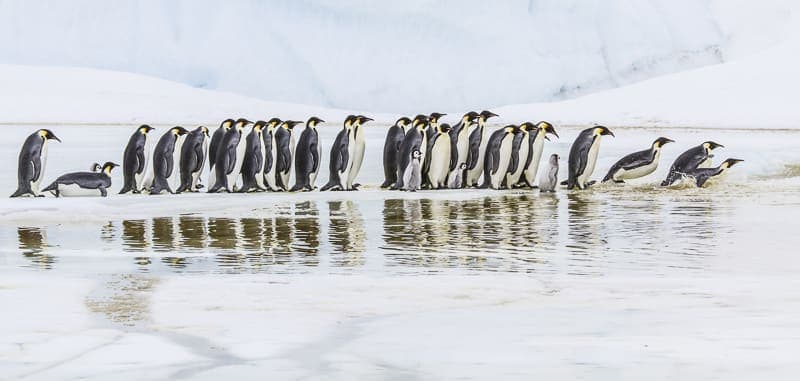
Emperor Penguins
Common Name: Emperor Penguin
Kingdom: Animalia
Phylum: Chordata
Class: Aves
Order: Sphenisciformes
Family: Spheniscidae
Genus and Species (Scientific Name): Aptenodytes forsteri
“Aptenodytes” is Latin for “large penguin.”
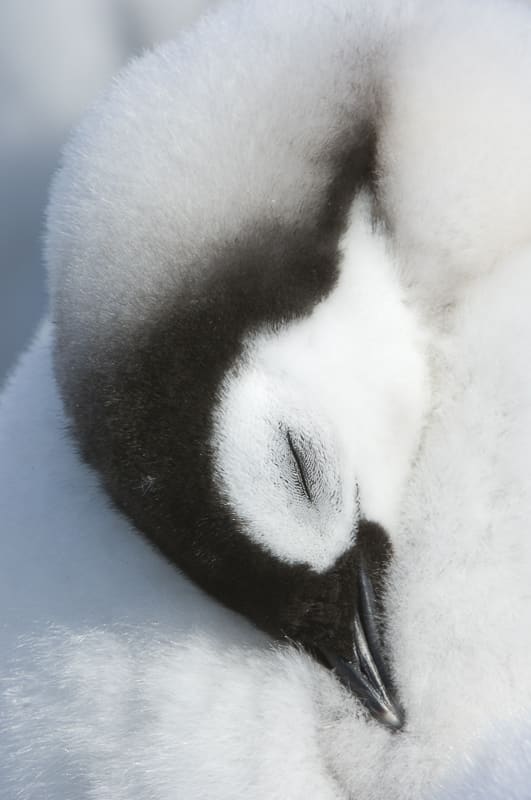
Emperor Penguin Chick
Emperor penguins eat fish mostly. They also consume some crustaceans – such as krill – and some cephalopods – for example, squid. Females travel up to 600 miles away from the Antarctic mainland to fill up on food while the males are incubating the eggs.
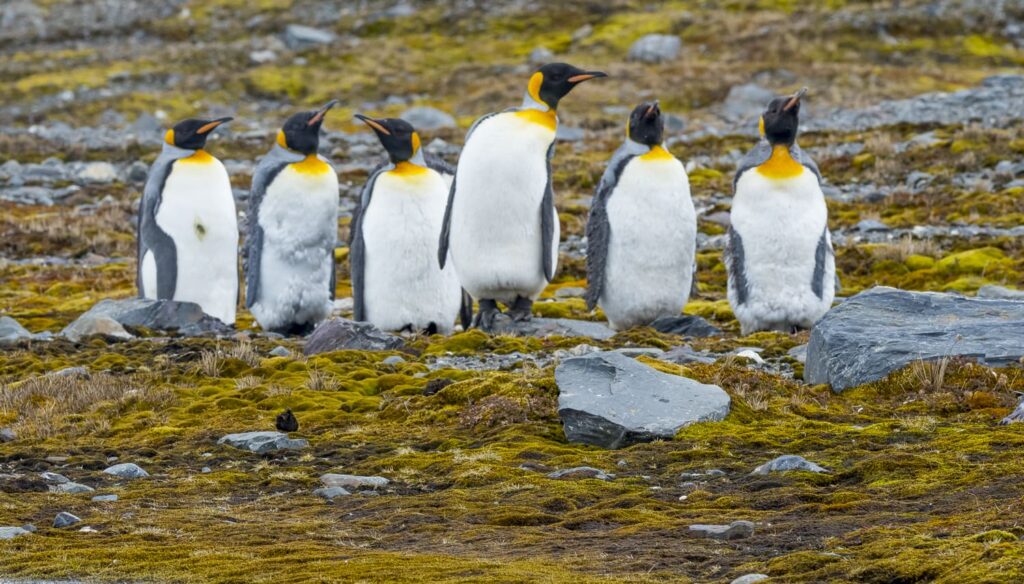
King Penguins
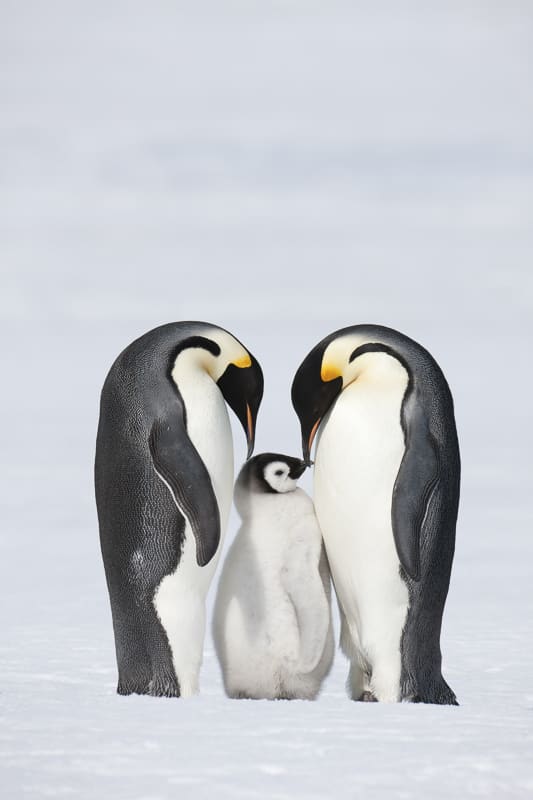
Emperor Penguins and Chick
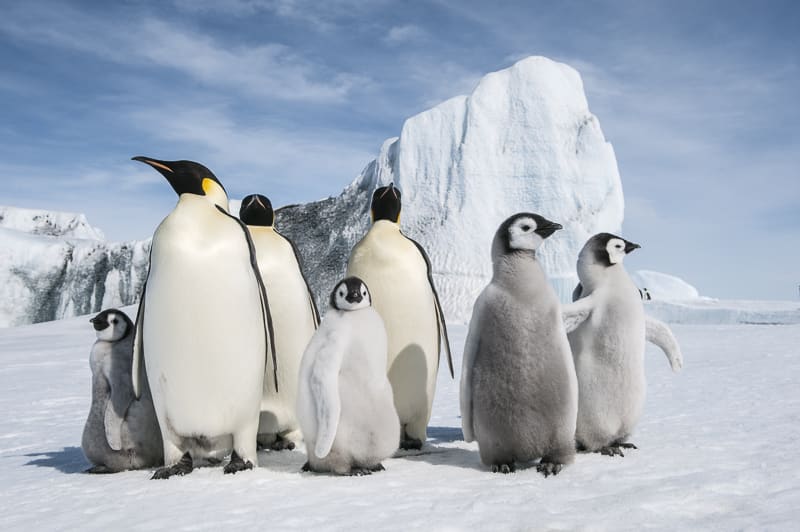
Emperor Penguins and Chicks
Emperor Penguins are threatened because of global climate change and overfishing activities caused by humans. Their habitats are changing rapidly each year and it is unknown how these animals will be able to adapt to this. Global fish stocks are declining because more fishing boats are venturing to Antarctic waters and the Southern Ocean – and this is creating pressure for Emperor Penguins who must now compete against humans for fish, krill, and squid. A recent study estimates that at least 20% of the Emperor Penguin population may die from Global Warming by the year 2100. This is because the penguins rely on sea ice for breeding colonies and sea ice is increasingly unstable and breaking up.
While penguins themselves are predators, they do have predators that eat them and their eggs. Emperor Penguin chicks are the most likely to fall prey to a predator. Seabirds – especially Giant Petrels and Skuas – and marine mammals that hunt – particularly Leopard Seals and Orca (Killer Whales). Some of the 19th Century human explorers to Antarctica were predators of Emperor Penguins because they were trying to survive harsh conditions and did not have other sources of food. All 18 species of penguin – including Emperors – are protected legally from both hunting and egg collecting. The Antarctic Treaty of 1959 is responsible for this.
By going on one of our Antarctic cruises, you can help contribute to Emperor Penguin conservation.
The Little “Blue” Penguin is the smallest species of penguin. Standing only 33 cm tall (13 inches) and possessing a length of just 43 cm (17 inches), this tiny penguin calls Australia and New Zealand home. It’s more common that New Zealanders will refer to them as little blue penguins, due to the color of their feathers. Another name commonly given to the species is the Fairy Penguin.
Little Blue Penguins do not migrate. They do not live in Antarctica or even in sub-Antarctic islands like South Georgia Island. Therefore, they are not a species you will be likely to encounter on an Antarctic polar cruise or holiday.
Newborn baby penguins are called “chicks.” Other words used for describing baby penguins are “nestling” or “hatchling.”
Many people will refer to them as “baby penguins.” Another term used is “young penguins.”

Gentoo Penguin and Chick
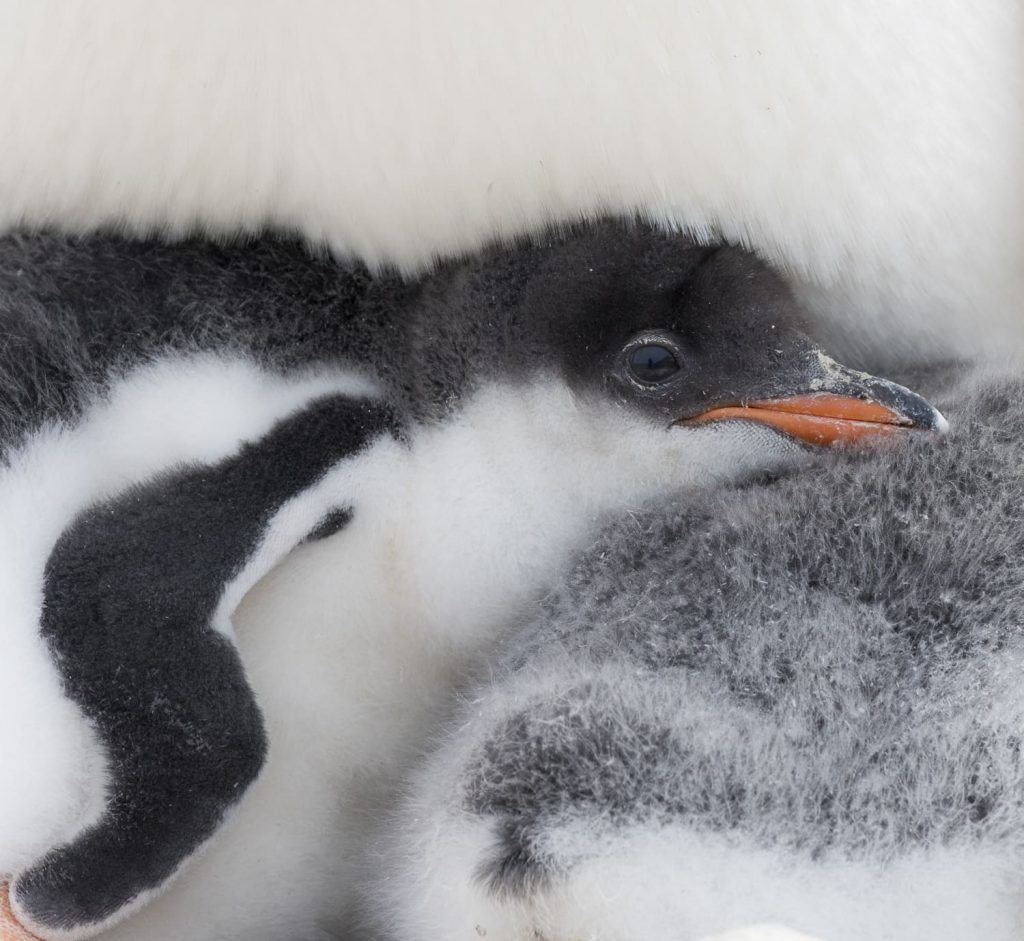
Gentoo Penguin Chick
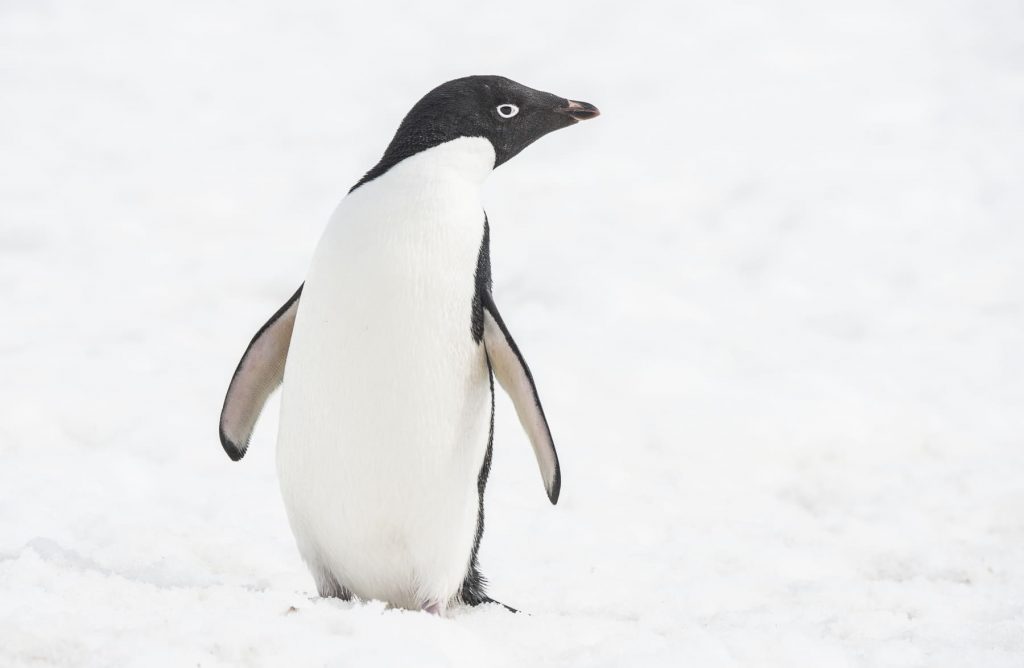
Adelie Penguin
Ready to find your dream cruise? Have questions? Contact Polar Holidays to schedule a free consultation with one of our booking specialists today!